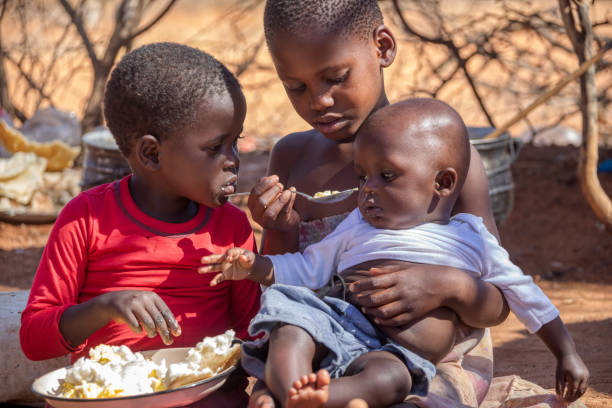IGAD Regional Focus of the 2025 Global Report on Food Crises released on 16/9/2025 shows that the number of people facing food crises levels has tripled in Kenya, South Sudan, Somalia, Uganda and Sudan from 13.9 million in 2016, to 41.7 million in 2025.Between April and June 2025, 2.8 million people or 17 percent of the analysed population were projected to face high levels of food insecurity in Kenya’s ASALs.
The latest integrated Food security Phase Classification (IPC) analysis highlights the worsening food insecurity and malnutrition crisis in Kenya’s ASALs( Arid and Semi Arid Lands).
Counties like Baringo (Tiaty), Garissa, Mandera, Marsabit (North Horr and Laisamis), Samburu, Turkana, and Wajir are already classified as Critical (IPC Phase 4) for acute malnutrition, with low dietary diversity among children and limited access to safe water exacerbating the crisis.
Deterioration into IPC Phase 4 was expected in Baringo (Tiaty), Turkana, Marsabit (North Horr and Laisamis), Samburu, and Mandera. Isiolo, Tana River, and West Pokot were projected to remain in IPC Phase 3. Garissa and Wajir were projected to shift from IPC AMN Phase 3 to IPC AMN Phase 4.
READ MORE: IGAD Weather Forecast for October – December Across Greater Horn of Africa
What are the Drivers of Food Insecurity in Kenya’s ASALs
The analysis projects that between February 2025 and January 2026, acutely malnourished children will hit 0.8M, Moderately malnourished(0.6M), Severely malnourished (0.2M), pregnant and breastfeeding women with acute malnutrition will hit 0.1M.
Weather extremes have resulted in food crises in the region. Take for example the 2023 OND(October-November-December) rains boosted agricultural production, but also triggered flooding. The floods displaced communities, damaged infrastructure and caused livestock losses between February-March 2024. The March-May 2024 long rains also caused flooding that affected more than 300,000 people.

Photo of floods after extreme weather conditions in Turkana / Unsplash Images
OND 2024 short rains that arrived late and were unevenly distributed disrupting crop development and pasture regeneration. Early 2025 recorded prolonged dry spells and forecasts warn that below-average OND 2025 rains could compromise food availability and staple food prices may remain high.
These weather extremes have disrupted grazing , reduced crop yields by 40-70 percent in agro-pastoral areas and strained water resources, elevating food prices and worsening malnutrition.
Conflict and Insecurity
Between 2024 and 2025, conflicts including resource- based disputes and human-wildlife interactions largely affected pastoralist communities. They contributed to loss of livestock and limited farmers’ access to the fields which in turn negatively affected agricultural production. (IPC March,2025)
Economic Shocks
Increased food prices are a key driver of acute food insecurity. Strong demand, expensive cross-border imports, high production and marketing costs drove increased prices.(IPC March,2024 and September 2025)
Contributing Factors of Acute Malnutrition in Kenya’s ASALs(2024–2025)
Lack of food/inadequate diets.
High levels of acute food insecurity continue to drive poor food consumption. Dietary intake among children aged 6–23 months is low.Example: In Garissa, just over 12% of children met the minimum dietary diversity (MDD), and only about 6% achieved the minimum acceptable diet (MAD).Exclusive breastfeeding rates were critical at an estimated 15% in Wajir (IPC, March 2025).
Disease burden
Persistent diseases are also a critical driver of recurrent acute malnutrition in the ASALs. In most counties, cases of acute respiratory infections rose, exceeding the long-term average in Garissa. The cases of diarrhoea were also high across most areas with malaria being endemic in regions like West Pokot, Baringo and Kajiado.
Inadequate services like outreaches and mass screenings in the affected areas have reduced due to the funding gaps with coverage of services including immunization, Vitamin A supplementation remain suboptimal.
The latrine coverage in those areas is less than 50 percent with less than 50 percent of households washing their hands or treating their water during critical times.
IGAD and partners are urging urgent climate adaptation measures, improved water management, and expanded food assistance to protect livelihoods. Without stronger climate-resilient food systems, communities in Kenya’s ASALs will remain vulnerable to increasingly erratic weather patterns fueled by climate change.

Photo: Farayi Zimudzi, Representative at FAO
FAo Subregional Coordinator for Eastern Africa ad-interim, Farayi Zimudzi insisted that there’s need to act promptly and ensure that farmers and pastoralists are well protected. She shared,
“Rural agricultural communities are among the worst affected. With another poor rainy season expected, we must act now with anticipatory actions. However, anticipatory action alone won’t break the cycle. They must be paired with long-term resilience building and investment in sustainable agriculture to ensure no one is left behind.”
Glossary of Key Terms
- IPC – Integrated Food Security Phase Classification
A global system used to measure how severe food insecurity or malnutrition is, ranging from Phase 1 (Minimal) to Phase 5 (Famine/Catastrophe). - IPC AMN – IPC Acute Malnutrition
A part of the IPC system that focuses specifically on nutrition, especially levels of child wasting (low weight for height) and related health risks. - MDD – Minimum Dietary Diversity
A nutrition measure for children (6–23 months) that checks if they ate foods from at least five out of eight food groups in a day. Low MDD means children are not getting enough food variety. - MAD – Minimum Acceptable Diet
A combined measure of diet diversity and meal frequency. It shows whether children not only eat enough food types but also eat often enough for healthy growth. - OND – October–November–December rains
A major rainy season in East Africa. OND rains are crucial for farming and livestock, but they can also cause flooding and displacement when unusually heavy. - ASALs – Arid and Semi-Arid Lands
Regions in Kenya that are hot, dry, and prone to drought. They cover about 80% of Kenya and are home to many pastoralist communities.





